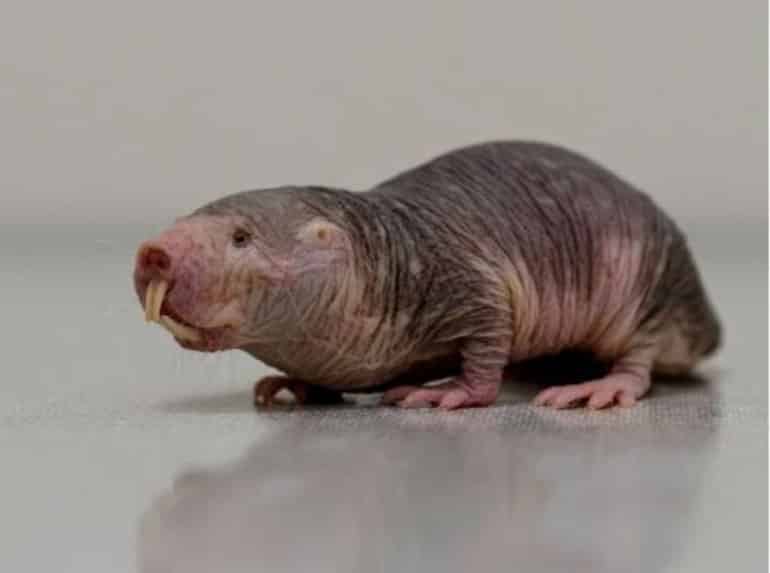Summary: Naked mole rats have a unique DNA repair mechanism that prevents them from developing cancers and neurodegenerative disorders, researchers say.
Source: University of Bradford
Scientists say naked mole rats – a rodent native to West Africa – may hold the key to new treatments for degenerative diseases such as cancer and dementia.
The reclusive animals have a lifespan far in excess of other rodents – for example, mice and rats live about two years, whereas naked mole rats can live for 40 or 50 years.
Researchers at the University of Bradford say the animals have a unique DNA repair mechanism that enables them to prevent cancers and other degenerative conditions, including dementia.
Cancer resistant
Professor Sherif El-Khamisy, Director of the Institute of Cancer Therapeutics at the University, said: “Naked mole rats are fascinating creatures, not least because they are so long lived compared to other rodents of the same size. They also do not suffer from – what we call in humans – age associated disorders, such as cancer, dementia and neurological decline.
“What we’re trying to do is to understand what makes them so resistant and then to try to harness that knowledge to come up with new treatments for cancer and conditions like dementia in people.
“This is not about extending life but extending the quality of life.”
DNA mutations
Prof El-Khamisy, from the University’s Faculty of Life Sciences, is the lead author of a paper, DNA Homeostasis and Senescence: Lessons from the Naked Mole Rat, recently published in the International Journal of Molecular Sciences.
It states: “As we age, our bodies accrue damage in the form of DNA mutations. These mutations lead to the generation of sub-optimal proteins, resulting in inadequate cellular homeostasis and senescence*. The build-up of senescent cells negatively affects the local cellular micro-environment and drives ageing associated disease, including neurodegeneration.
“Which processes show an increased burden as naked mole rats age may identify novel biological targets to mitigate our own degeneration.”
Prof El-Khamisy added: “This is a new area of research, so there are still lots of things we don’t know. For example, Alzheimer’s and dementia are caused by protein aggregations in the brain and this has been a puzzle to scientists for many years. There are questions around how those proteins form and also how the body deals with them. Clearly, naked mole rats are much better than us at dealing with them.

“If we can work out how they do this, we could look to adopt similar systems in humans or to use these markers as a predictive tool to be able to say ‘this person is more likely to develop dementia or cancer as they age’, and then take appropriate steps.”
Naked mole rats fact file
Naked mole rats are mostly hairless, wrinkly rodents that grow to between three and 13 inches.
They live for 40 or 50 years and are immune to cancer and some types of pain, such as that from biting insects and spicy plants.
In the wild, they live in hierarchical colonies (with a queen, soldiers and workers) sometimes numbering up to 300, creating a warren of underground tunnels and rooms the size of several football pitches.
They live most of their lives in caves or underground, yet despite their lack of exposure to the sun, they have a strong circadian rhythm.
About this cancer and dementia research news
Source: University of Bradford
Contact: Neil Hudson – University of Bradford
Image: The image is credited to University of Bradford
Original Research: Open access.
“DNA Homeostasis and Senescence: Lessons from the Naked Mole Rat” by Sherif El-Khamisy et al. International Journal of Molecular Sciences
Abstract
DNA Homeostasis and Senescence: Lessons from the Naked Mole Rat
As we age, our bodies accrue damage in the form of DNA mutations. These mutations lead to the generation of sub-optimal proteins, resulting in inadequate cellular homeostasis and senescence.
The build-up of senescent cells negatively affects the local cellular micro-environment and drives ageing associated disease, including neurodegeneration. Therefore, limiting the accumulation of DNA damage is essential for healthy neuronal populations.
The naked mole rats (NMR) are from eastern Africa and can live for over three decades in chronically hypoxic environments. Despite their long lifespan, NMRs show little to no biological decline, neurodegeneration, or senescence.
Here, we discuss molecular pathways and adaptations that NMRs employ to maintain genome integrity and combat the physiological and pathological decline in organismal function.






